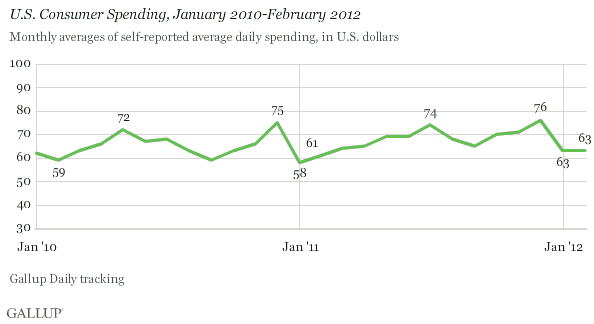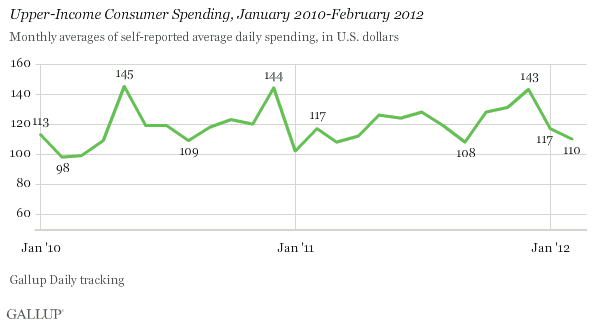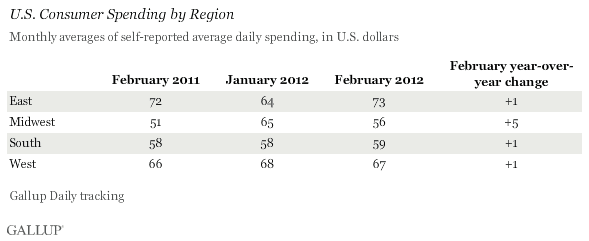PRINCETON, NJ -- Overall self-reported daily U.S. consumer spending in stores, restaurants, gas stations, and online was unchanged in February, averaging $63 per day -- the same as in January. Spending was $61 in February a year ago.

Lower- and Middle-Income Americans' Spending Increases Slightly
Americans who make less than $90,000 per year reported spending an average of $55 per day during February -- essentially the same as the $54 they spent in January. Lower- and middle-income spending was $52 in February 2011.

Upper-Income Spending Down Slightly
Spending among Americans making at least $90,000 annually averaged $110 per day in February, down slightly from the $117 of January and of February 2011. This group's spending last month was at its lowest level since September 2011.

Americans' Spending Up in the Midwest but Flat in All Other Regions
Spending in February was higher than in January in the East but was down in the Midwest. On the other hand, Americans' spending showed an increase year-over-year in the Midwest but was flat in all other regions.

Implications
The modest 3.3% increase in year-over-year consumer spending, as measured by Gallup, is consistent with the positive February sales reports of many of the nation's retailers. While Gallup's self-reported spending results tend to differ from those of retail sales, they are often fairly well aligned with chain-store sales. Gallup's year-over-year spending results also tend to benefit -- as do many retailers -- from the weak sales comparables of a year ago.
Further, the improvement in February consumer spending year-over-year is concentrated in the Midwest. While this region of the country has enjoyed the best job situation of any region early this year, some of this sales improvement may be the result of the mild weather in some parts of the country.
At the same time, the improvement in consumer spending appears to be driven by an increase in lower- and middle-income, not upper-income, spending. A spending increase by these first two groups of Americans, who tend to have limited disposable income, may not be maintainable.
Wall Street cheered the better-than-expected sales for many individual retailers in February. However, those cheers were tempered by surging gas prices at the pump. Experience suggests that as gas prices increase rapidly, consumers -- particularly lower- and middle-income consumers -- tend to pull back on their spending. Of course, whether upper-income Americans ignore gas prices, end their "frugality fatigue" in light of the gains on Wall Street, and keep the U.S. economy moving forward even as other Americans pull back is yet to be seen. However, if such a scenario is forthcoming, Gallup Daily tracking is not yet showing signs of it.
Gallup.com reports results from these indexes in daily, weekly, and monthly averages and in Gallup.com stories. Complete trend data are always available to view and export in the following charts:
Daily: Employment, Economic Confidence, Job Creation, Consumer Spending
Weekly: Employment, Economic Confidence, Job Creation, Consumer Spending
Read more about Gallup's economic measures.
View our economic release schedule.
Survey Methods
For Gallup Daily tracking, Gallup interviews approximately 1,000 national adults, aged 18 and older, each day. The consumer spending results are based on a random sample of approximately 500 current full- and part-time employees each day.
National results for February are based on Gallup Daily tracking interviews with 13,273 national adults conducted Feb. 1-29, 2012. For this sample, one can say with 95% confidence that the maximum margin of sampling error is ±1 percentage point.
Upper-income results are based on Gallup Daily tracking interviews with 2,463 national adults conducted Feb. 1-29, 2012. For this sample, one can say with 95% confidence that the maximum margin of sampling error is ±3 percentage points.
Middle- and lower-income results are based on Gallup Daily tracking interviews with 8,653 national adults conducted Feb. 1-29, 2012. For this sample, one can say with 95% confidence that the maximum margin of sampling error is ±1 percentage point.
Regional results are based on Gallup Daily tracking interviews with 2,700 or more national adults per region conducted Feb. 1-29, 2012. For this sample, one can say with 95% confidence that the maximum margin of sampling error is ±3 percentage points.
Interviews are conducted with respondents on landline telephones and cellular phones, with interviews conducted in Spanish for respondents who are primarily Spanish-speaking. Each sample includes a minimum quota of 400 cell phone respondents and 600 landline respondents per 1,000 national adults, with additional minimum quotas among landline respondents by region. Landline telephone numbers are chosen at random among listed telephone numbers. Cell phone numbers are selected using random-digit-dial methods. Landline respondents are chosen at random within each household on the basis of which member had the most recent birthday.
Samples are weighted by gender, age, race, Hispanic ethnicity, education, region, adults in the household, and phone status (cell phone only/landline only/both, cell phone mostly, and having an unlisted landline number). Demographic weighting targets are based on the March 2011 Current Population Survey figures for the aged 18 and older non-institutionalized population living in U.S. telephone households. All reported margins of sampling error include the computed design effects for weighting and sample design.
In addition to sampling error, question wording and practical difficulties in conducting surveys can introduce error or bias into the findings of public opinion polls.
For more details on Gallup's polling methodology, visit www.gallup.com.
